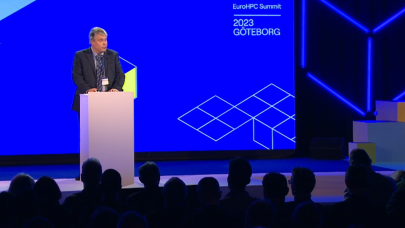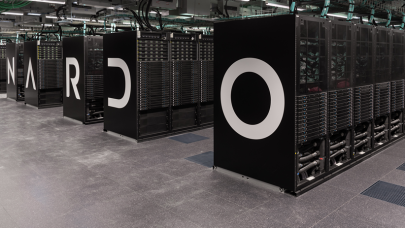
Top500: Aurora Is in the House, But It Is Still Frontier’s Party
November 13, 2023
The fall 2023 TOP500 list is out and Frontier retains its top spot and is still the only exascale machine. However, five new or upgraded systems have shaken up Read more…

EuroHPC Executive Director Talks Europe’s Supercomputing Future
May 1, 2023
Following the EuroHPC Summit conference in Gothenburg, Sweden, last month, HPCwire asked Steve Conway, senior analyst at Intersect360 Research, to interview And Read more…

Destination Earth Takes Form as EuroHPC’s Flagship Workload
March 30, 2023
When the EuroHPC Summit was held last week in Gothenburg, there was a distinct shift in tone for the maturing supercomputing play. With LUMI and Leonardo – pl Read more…

EuroHPC Summit: Tackling Exascale, Energy, Industry & Sovereignty
March 24, 2023
As the 2023 EuroHPC Summit opened in Gothenburg on Monday, Herbert Zeisel – chair of EuroHPC’s Governing Board – commented that the undertaking had “lef Read more…

Leonardo Supercomputer Approved for ‘LISA’ Upgrade
December 15, 2022
Fresh off its inauguration just weeks ago, the EuroHPC-organized, Cineca-operated Leonardo supercomputer has been approved for a major expansion called LISA. Th Read more…

Europe’s Digital Twins for Earth Kick Off, Crown Jewel Supercomputers in Tow
October 19, 2022
In late 2020, the European Union announced plans for its Destination Earth (“DestinE”) moonshot project to create multiple digital twins of Earth, including Read more…

As LUMI Launches, a Look at the State of EuroHPC
June 13, 2022
Today, the LUMI pre-exascale supercomputer was inaugurated in Kajaani, Finland. LUMI—which currently weighs in around 152 Linpack petaflops, but is expected to soon exceed 375—represents the largest success thus far of the EuroHPC Joint Undertaking, Europe’s concerted supercomputing play. LUMI marks the beginning of the end for the first phase of EuroHPC, but the... Read more…

EuroHPC Issues Calls for Quantum Computers, System Upgrades
April 1, 2022
Last September, the EU’s EuroHPC Joint Undertaking was budgeted through 2027, announcing a slew of major goals for that timeframe. Among them: quantum computi Read more…

- Click Here for More Headlines

Whitepaper
Transforming Industrial and Automotive Manufacturing
In this era, expansion in digital infrastructure capacity is inevitable. Parallel to this, climate change consciousness is also rising, making sustainability a mandatory part of the organization’s functioning. As computing workloads such as AI and HPC continue to surge, so does the energy consumption, posing environmental woes. IT departments within organizations have a crucial role in combating this challenge. They can significantly drive sustainable practices by influencing newer technologies and process adoption that aid in mitigating the effects of climate change.
While buying more sustainable IT solutions is an option, partnering with IT solutions providers, such and Lenovo and Intel, who are committed to sustainability and aiding customers in executing sustainability strategies is likely to be more impactful.
Learn how Lenovo and Intel, through their partnership, are strongly positioned to address this need with their innovations driving energy efficiency and environmental stewardship.
Download Now
Sponsored by Lenovo
Whitepaper
How Direct Liquid Cooling Improves Data Center Energy Efficiency
Data centers are experiencing increasing power consumption, space constraints and cooling demands due to the unprecedented computing power required by today’s chips and servers. HVAC cooling systems consume approximately 40% of a data center’s electricity. These systems traditionally use air conditioning, air handling and fans to cool the data center facility and IT equipment, ultimately resulting in high energy consumption and high carbon emissions. Data centers are moving to direct liquid cooled (DLC) systems to improve cooling efficiency thus lowering their PUE, operating expenses (OPEX) and carbon footprint.
This paper describes how CoolIT Systems (CoolIT) meets the need for improved energy efficiency in data centers and includes case studies that show how CoolIT’s DLC solutions improve energy efficiency, increase rack density, lower OPEX, and enable sustainability programs. CoolIT is the global market and innovation leader in scalable DLC solutions for the world’s most demanding computing environments. CoolIT’s end-to-end solutions meet the rising demand in cooling and the rising demand for energy efficiency.
Download Now
Sponsored by CoolIT
Advanced Scale Career Development & Workforce Enhancement Center
Featured Advanced Scale Jobs:
HPCwire Resource Library
HPCwire Product Showcase
© 2024 HPCwire. All Rights Reserved. A Tabor Communications Publication
HPCwire is a registered trademark of Tabor Communications, Inc. Use of this site is governed by our Terms of Use and Privacy Policy.
Reproduction in whole or in part in any form or medium without express written permission of Tabor Communications, Inc. is prohibited.
























